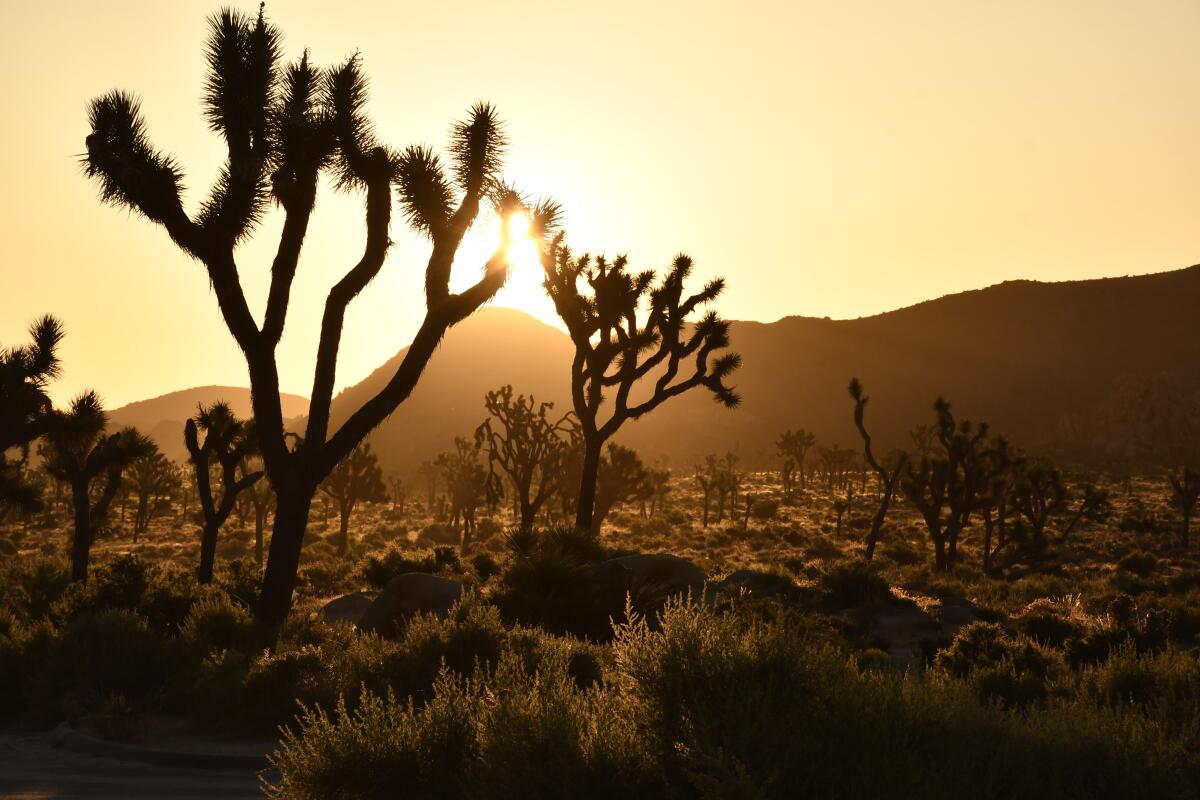Editorial: Joshua trees, threatened by climate change, deserve California’s protection

The Joshua tree, a singular but imperiled fixture of California’s high desert, faces a dim long-term future because of the interconnected threats of development, wildfire, drought and climate change.
But efforts to ensure that these beloved trees survive into the next century have encountered a serious setback. In a report made public Wednesday, scientists with the California Department of Fish and Wildlife recommended against listing the Joshua tree as threatened under the state Endangered Species Act, saying it is not in serious danger of extinction in the foreseeable future.
It’s a troubling development because it follows decades of warnings from scientists that Joshua trees face an existential threat from climate change and could be wiped out if more isn’t done to protect them.
The recommendation came in response to a 2019 petition by the Center for Biological Diversity that sought to protect the western Joshua tree, one of two distinct species that live in California and cited climate change as the “single greatest threat” to its continued existence.
The finding bodes ill for the spindly trees with sharp, bayonet-shaped leaves and shaggy outstretched limbs that evoke arms extending toward the sky. Scientists project the western Joshua tree could lose upwards of 90% of its current habitat in the Mojave Desert by the end of the century as hotter, drier conditions from climate change and other human and environmental pressures increasingly cause it to die off.
The state’s scientific review says climate change is expected to keep fueling declining numbers of western Joshua trees in the coming decades, especially in the southern, lower-elevation portions of its range, where up to 42% of its habitat may be lost to urban growth and renewable energy development by the end of the century. But the department said it does not foresee the tree “is likely to be in serious danger of becoming extinct” by the end of the century due to climate change.
Joshua trees are “currently abundant and widespread, which lessens the overall relative impact of the threats to the species, and substantially lowers the threat of extinction within the foreseeable future,” the report said.
But it would be shortsighted for state wildfire officials to do nothing to protect trees that can live for about 200 years because they are not at imminent risk of extinction. Delaying action will only make it harder to save them.
Notably, some of the independent peer reviewers of the state’s report criticized its assumptions and conclusions, saying the department overstates the uncertainty of the science and mischaracterizes climate change as a future, rather than a current threat, when in fact there is no doubt that Joshua trees are at risk of being eliminated from most of their current range without additional protections.
The state Fish and Game Commission has final say over whether to list Joshua trees as threatened, with a decision expected this summer. If it decides not to list Joshua trees as threatened, temporary legal protections the commission granted in 2020 making it illegal to kill them without special permits would end.
But the panel’s five governor-appointed members have an opportunity to take a more expansive and precautionary approach that acknowledges the threat-multiplying effect of climate change, which has already caused extinctions and threatens widespread loss of species worldwide. A state listing is seen as the best hope of saving California’s Joshua trees after the U.S. Fish and Wildlife Service in 2019 found that Joshua trees across the Southwest did not warrant federal endangered species protections.
There are powerful development interests fighting an endangered species designation for the Joshua tree, including renewable energy companies that face restrictions on solar and wind power projects that require clearing them out of the way. But the fact that the Joshua trees are at the center of competing demands, to produce carbon-free electricity that will help slow climate change on one side and to preserve desert land on the other, only shows the value of the type of careful planning and consideration that would be afforded by listing them as threatened.
Wildlife officials can use their power proactively to gird California’s imperiled desert for the impacts of climate change and help save a key species from eradication.
More to Read
A cure for the common opinion
Get thought-provoking perspectives with our weekly newsletter.
You may occasionally receive promotional content from the Los Angeles Times.






